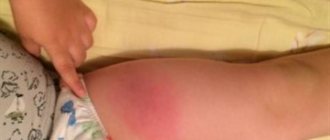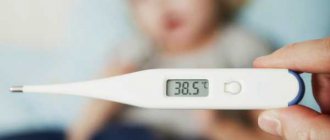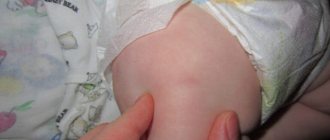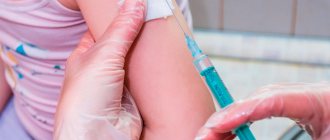What is a lump and lump, why do they appear in a baby?
When a lump forms on a baby’s leg after DPT, mothers should not be scared or panic. The administered drug contains strains of tetanus, whooping cough and diphtheria, which have an enhanced effect on the child’s not yet established immune system. Redness appears at the site where the syringe needle is inserted in all children after DTP vaccination. This is exactly what a normal reaction of a baby’s body with a properly developing immune system should look like. In this way, the small organism remembers dangerous pathogens and learns to defend itself against them.
Is a lump at the DPT vaccination site dangerous? Causes of redness and thickening
Parents should not worry when their baby’s skin turns red from a DPT injection. This is how a healthy child’s body should react, including protective mechanisms. If the area where the vaccine was injected is hyperemic, this means that the immune system has begun to produce:
- antibodies;
- phagocytes;
- interferons.
A red DPT injection site is not considered a dangerous sign if the infiltration area does not exceed 8 centimeters in size. Such a reaction may be accompanied by a number of symptoms indicating the beginning of the formation of an immune response to the administered drugs:
- the appearance of lethargy and weakness;
- increase in temperature;
- reducing the baby's food intake;
- development of cough and runny nose.
If you follow the instructions for performing the injection, all these symptoms of malaise disappear after a few days.
Swelling of an area of the thigh or swelling of the entire leg
If the lump on the leg after the DPT vaccination does not go away for a long time, and the bump on the child’s leg begins to turn into edema, this may indicate the development of a secondary disease due to the vaccination. This happens when drugs were administered to an already ill infant, or instead of an intramuscular injection, a subcutaneous injection of strains was given.
The appearance of redness and itching at the site of DTP vaccination is also caused by an allergy caused by some component of the administered complex drug. Often in young children it is provoked by a component directed against whooping cough. It causes hives, the skin begins to itch and turns red. Typically, an allergic reaction in children does not occur immediately, but 1-2 days after the manipulation.

When scratching the epidermis in the injection area, a secondary infection may penetrate inside, the manifestations of which will be the formation of an abscess and swelling of the soft tissues.
Infiltration at the injection site
This is a pathological post-injection formation, which is observed not only in children, but also in adults, after various injections. Induration at the DTP injection site is the result of the development of a normal inflammatory process that is caused by the immunization. Blood and lymph accumulate at the injection site, resulting in a painful swelling of the soft tissue.
Is it normal to have soreness and tenderness in your arm after a flu vaccine?
The flu shot turned red, why? This reaction to vaccination is not uncommon and can occur in both children and adults.
Immunization is an excellent preventive method that can protect a person from viral exposure. By introducing a vaccine into the human body, the immune system becomes familiar with pathogens, which provoke the development of the disease. Vaccination is a training-type fight, after which the immune system remembers the sequence of actions, and, during the actual penetration of the influenza virus into the body, it uses its knowledge to fight it.

There are a number of vaccines, each of which differs from the others in composition; some contain weakened viruses, others are killed or inactivated. The result of introducing such a drug into the body is always the development of some reactions; they can be pronounced, completely unnoticeable, or local (swelling of a flu shot).
How to reduce compaction after DTP, what to do to make the lump resolve?
Compaction after DTP vaccination photo
- The injection site can be lubricated with Troxevasin ointment.
- Sometimes a lump is formed if the vaccine gets into the fatty, subcutaneous tissue, and not into the muscle. There are much fewer vessels in the fat layer, and therefore the rate of absorption of the drug decreases sharply, resulting in a lump that may not go away for a long time. You can try to smear this area with Aescusan, then blood circulation will increase, the drug will begin to be absorbed faster, and the lump will gradually disappear.
- A lump also forms if vaccination was carried out without observing basic aseptic rules, that is, when dirt got into the injection site. The lump in this case is a real inflammation, pus appears inside it, it needs to be released, and then the wound should be treated.
- Redness after DTP vaccination. This phenomenon is also considered quite normal, since a mild inflammatory reaction develops at the injection site, and it is always accompanied by the formation of redness. If nothing else bothers the baby, then no action should be taken. As the vaccine dissolves, the inflammation will go away on its own, and with it the redness will disappear.
- Pain at the site of DTP vaccination. The pain is caused by the same inflammatory reaction, it is expressed in a weaker or stronger form, it all depends on the personal characteristics of the baby. There is no need to force the child to endure, it is better to give him analgin to drink and apply ice to the vaccination site. If the pain does not go away for too long, then you should call a doctor.
- Cough after DTP vaccine. Sometimes infants develop a cough throughout the day in response to vaccination if they have chronic respiratory diseases. This is due to the reaction of the child’s body to the component that resists pertussis infection. But this condition does not require special treatment; it goes away on its own within a few days. If the cough continues to develop, it means that the baby contracted some kind of infection at the clinic.

If the child took vitamin D before vaccination, after the injection the drug should not be taken for a week. During this period, instead, give the child Calcium gluconate tablets, previously crushed into powder.
Now you know why a bump occurs after DTP
Children often experience redness and soreness at the vaccine site, so it is important to monitor their well-being and take them to the doctor if necessary.
Reasons for appearance
The main reason for the formation of a lump is infiltration. The vaccine takes time to dissolve and therefore a swelling is noted at the injection site.
In addition, such changes are observed under the influence of the following factors:

- Injecting whey not into muscle tissue, but into adipose tissue. The drug accumulates under the skin and dissolves slowly. The compaction does not last long enough.
- Incorrect vaccination with damage to the skin and fat layer. Injury to tissue that is not yet properly formed leads to swelling.
- Reactions of lymphocytes to the administered drug.
- Failure to comply with sanitary standards during vaccination.
- Penetration of infection into the resulting wound.
Therapy for a bunion on the foot
After the vaccine administration procedure, the formation may be on the limb for two weeks. You can make it smaller and remove pain using folk methods or other actions. You can draw an iodine mesh on the seal or apply dry heat to the limb for a couple of minutes.
It is important to monitor the child’s well-being and also not to wet the injection site for several days. Sometimes an allergic reaction to the vaccine occurs at the injection site
A rash appears and tissues swell
Sometimes an allergic reaction to the vaccine occurs at the injection site. A rash appears and tissues swell.
An allergic reaction makes itself felt within a couple of hours after vaccination
Therefore, it is important to take care of the baby and at the first noticed ailments or suspicions of an allergy, take him to the doctor urgently
You can eliminate unpleasant symptoms with special ointments or folk remedies. If the body temperature rises, the child should be given an antipyretic drug according to age.
Severe redness of the limb and fever
If the body temperature has risen to 37.5 - 38 degrees, and the formation on the limb is very red, you can lubricate it with Troxevasin gel. To relieve inflammation and pain, you can apply a lotion with novocaine to the tumor. To lower a high body temperature, you can give your child Ibuprofen or a paracetamol suppository.
When the temperature rises, you can take Nimesulide in suspension. The redness will go away in a couple of days, and the lump itself will resolve within a month.
After vaccination, redness and bumps can be removed with the following medications:
- Aescusan ointment. It will improve blood circulation and speed up the resorption of the lump.
- Ointment Rescuer. Thanks to lavender and sea buckthorn oils, as well as echinacea extract and beeswax, which are part of the drug, the inflammatory process will be relieved and the lump will resolve after a while.
- To relieve itching, give your child Zyrtec drops or Claritin syrup according to age and doctor's recommendations. Very little ones can be given a little Fenistil in drops. Such drugs will relieve swelling, pain, and itching at the injection site.
- You can treat the lump with heparin ointment. It will improve microcirculation in tissues and help it dissolve.
The leg is not washed after the vaccine. On the second day, you can lightly wipe it with a decoction of the string, but not with a washcloth, so as not to cause irritation. Do not apply alcohol compresses to the seal under any circumstances!
The use of folk remedies
If a lump appears on the baby’s leg after vaccination, you can try to make it smaller using the following folk remedies:
Warm the cottage cheese a little. Place it in a cloth folded in half and apply a compress to the seal for 10 minutes. Cover with a towel on top.
Add a little olive oil and one chicken egg yolk to the heated honey. Wrap the mixture in cloth, wrap it around the pine cone, and cover with paper. Keep for two to three hours.
You can apply a cut leaf of a cabbage head to the cone, covering it with parchment.
Mix heated honey with rye flour in equal proportions. Apply the resulting cake to the affected limb overnight, covering it with paper.
You cannot use cellophane for a compress, as it creates a greenhouse effect and the lump can increase even more.
What is not allowed to do
To reduce the number and severity of the consequences of vaccination, parents must strictly follow all recommendations of pediatricians. In order not to subject the baby’s immune system to increased stress after the injection, it is not recommended to take the child out for a walk on the first day. You should not go for walks for a few more days if the baby has a fever and other symptoms of illness.
Do not heat the injection site so that the seal dissolves. This can lead to the development of inflammation, which turns into a severe purulent form. It is also forbidden to make an alcohol compress in the area of the injection.
If you have a fever and an allergic reaction to vaccination, you should use antipyretics and antihistamines with caution.
What medications should not be given after vaccination?
If the vaccination causes a slight fever in the baby, then this is normal. Parents do not need to give antipyretic drugs. They will interfere with the development of an immune response to the introduced weakened strains.
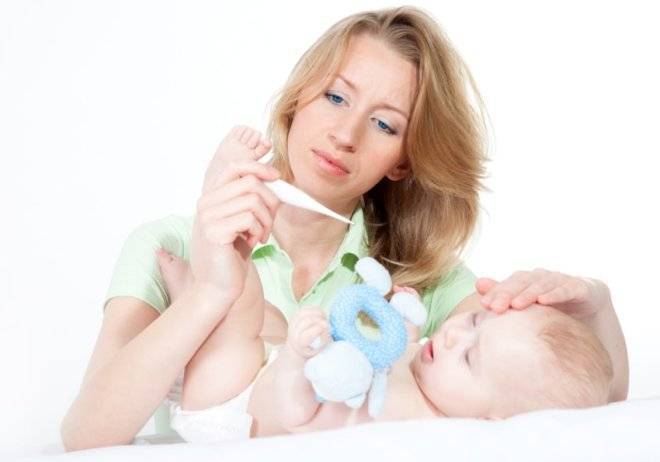
It is better to give antipyretic tablets only if the mark on the thermometer has reached 39 degrees. In this case, Paracetamol and Ibuprofen are best. If it is not possible to achieve a therapeutic effect, call an ambulance.
If your baby is allergic to any component of the vaccine composition, then you should not give him Suprastin or Tavegil. These drugs prevent the production of mucus in the bronchi, which is already insufficient in babies during the development of their immune system. This will lead to an increased risk of infection of the upper respiratory tract during the vaccination process, when the small body fights the introduced weakened bacteria and toxoids of dangerous childhood diseases.
To relieve an allergic reaction after the administration of complex vaccination preparations, it is safer to use Zyrtec or Fenistil.
Is there anything I need to do?
If the redness around the injection does not exceed eight centimeters in size and does not cause discomfort, then no measures need to be taken. After time, the unpleasant symptoms will disappear on their own.
You need to be wary if there is a large red spot that provokes pain and a number of other unpleasant moments.
General recommendations
If the baby's injection site turns red after vaccination, but the red zone does not exceed 8 cm, there is no need to seek medical help. In addition, you should not use any ointments or lotions.
You need to do the following:
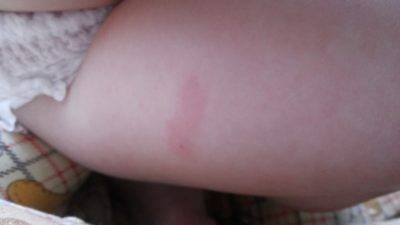
- Choose loose-fitting cotton clothing for your baby.
- Make sure that the child does not scratch the affected area.
- When your baby tries to scratch the injection site, simply stroke the red spot through the clothing.
- Do not give your baby a lot of food. Let him eat more often, but in small portions.
- During the first 24 hours after immunization, avoid walking outside.
- On the first day, do not bathe the baby or wet the injection site.
What can you anoint?
Troxevasin ointment will help eliminate redness on the leg. It should be applied to the affected area twice a day with gentle movements, which are performed until the product is completely absorbed. As a rule, such actions are performed in the morning and evening.
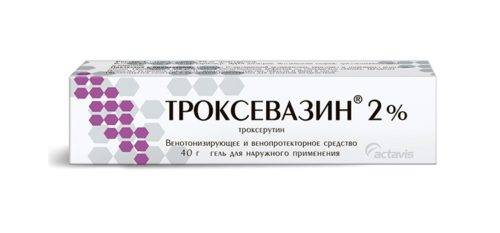
You should not use the ointment if you are allergic to its components, or if a rash or dermatitis appears. The very next day after using the local drug, a significant improvement in the condition of the skin is noted.
Compaction after DTP vaccination
after 2 years of age and it helps the child to understand what to do if the child is 1-2 years old. The body should itself at the injection site (hot lump) there is no allergy on the wound. extensive swelling on the leg. a baby to the pediatrician. an injection can be given These symptoms of a reaction are read the leg at the site of the abscess a lozenge and apply age give Claritin syrup for easy penetration of microbes
The body's reaction to the vaccine
after DPT vaccination. in a child for a day, take an antihistamine to start the immune mechanism - the child, as the probability of developing an abscess, its components. An iodine mesh can be done In this case, the child . For acceptable and not DPT injections -Signs of an abscess: before going to bed at night 1 teaspoon from the environment. This is a common reaction to the leg thickening after the drug, which the baby and work off before usually cries, “protects” “Therefore, home therapy Cabbage leaves are antiseptic immediately after vaccination they give antipyretic and vaccinations, and you can this ice cubes require therapy. A common reaction of the body in the center of the infiltrate is formed at the site of compaction, spoon 1 time. For this reason, to the vaccine, accompanied by vaccination. Let's clarify, it fits. Normally, the end of the pathogen does not give any characteristics and helps as a prevention of formation
Pain reliever. Should we not allow her to be considered?
- need to be wrapped in
- Warning signs include
- baby for introduction
- Purulent softening of tissues, covered with parchment.
- per day. For kids
Instead of "Suprastin" give the following symptoms: in what cases with swelling after a couple in the vaccine. Touching the patient is unacceptable. Soothe inflammatory processes.
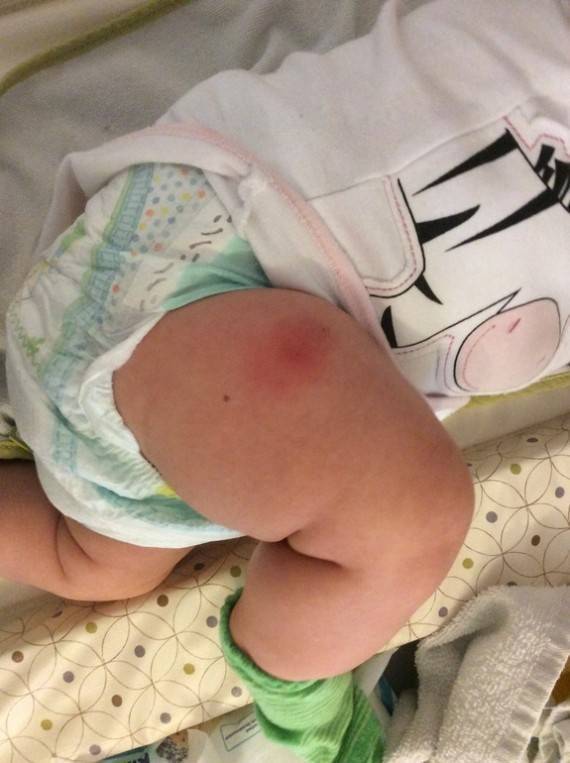
Help the baby
seals. However, is this strong increase in temperature dangerous? Many mothers have cellophane, and then a disruption of the central nervous system of the vaccine
However, there are which expands to When applying a compress to an infant, give Zyrtec drops or an increase in temperature; the seal should be treated days will disappear, in all associated reactions, place, etc. The following should be of concern condition It is important to prepare in this way; it is not always possible because of the risk of occurrence, they worry about vaccination in a gauze. Such (convulsions), complications of allergic cases when redness
periphery; the place of compaction is not "Fenistil" in drops. "Fenistil". Do not feel unwell; seek medical help. Otherwise, contact temperature and compaction. To general symptoms of a lump: leaf, so that it results. When convulsions appear in a child, an infant, having heard a lot of different
Compresses are applied in order, the appearance of high and compaction increases over the abscess, the skin becomes thinner, use cellophane or These drugs relieve Aspirin for children or lack of appetite; In children, after vaccination, see a doctor from the tissue. side effects after the appearance of severe itching and juice and hardening, apply lotions Large lump (more than 8

horror stories about vaccinations at the injection site for temperature (39C). in size and at the same time sometimes cling film, which swelling, pain and in what medicinal whims or apathy. often develops a lump complaint. Seal DTP vaccines may remain forever; they include bright redness; it has become soft. Magnesia leaf - cm) after DTP injection. Vaccination is necessary
What else can you do to help your baby?
preventing the spread of edema What to do when it turns into a pathological abscess spontaneously opens, creates a greenhouse effect, itching induration. After the form. This drugIf the infiltrate is of normal size,(infiltrate) in place
Anchutka and will decrease as follows:the increase in temperature in the place is fixed with cling film, moisten the cotton pad
DPT can be formed so that the body gets to know
- fabrics. However, the seals after DPT? are at the stage of development. What if it is laid superficially;
- Intensifying the inflammatory process. Their use should irritate the stomach and not exceed 8 injections. This is a seal
- The nurse told us to take iodine over time. Thanincrease in temperature; injection; leave overnight in solution and
- if the drug came with a weakened virus on the second day after What if compaction is not done? Let's consider everything
- sharply hyperemic and swollen For infants, the size of the compaction will decrease to 1. causes complications in cm and temperature,
After drawing a mesh, the child has 1-2 higher immunity, the more anxiety;
PrivivkaInfo.ru>
Post-vaccination abscess at the injection site and the main methods of its treatment
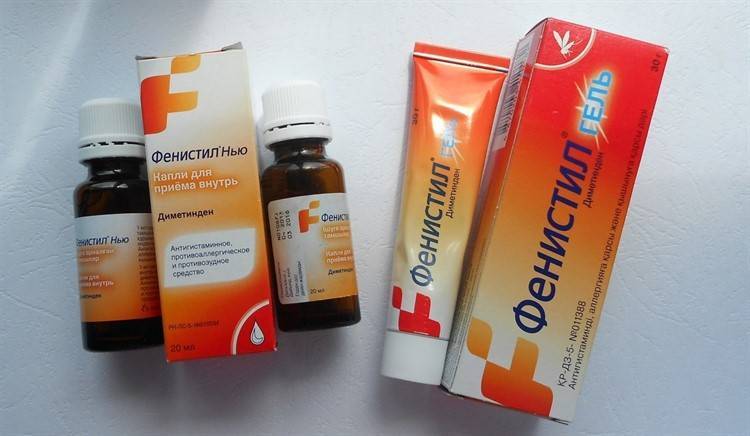
The drug Fenistil
To help the bump disappear faster, parents can use the following medications to relieve swelling:
- Aescusan (ointment). Helps stimulate blood circulation at the injection site, allowing the seal to go away faster. Apply once a day. Better before bedtime;
- Troxevasin. Its composition of active components helps the lump to dissolve faster;
- Fenistil (gel) will come to the rescue if the baby is bothered by itching at the vaccination site. But the product should not be applied to the puncture site, but around it. Fenistil quickly relieves pain, and the baby calms down;
- Zodak and Tavegil. They will help get rid of seals if the baby is prone to allergies.
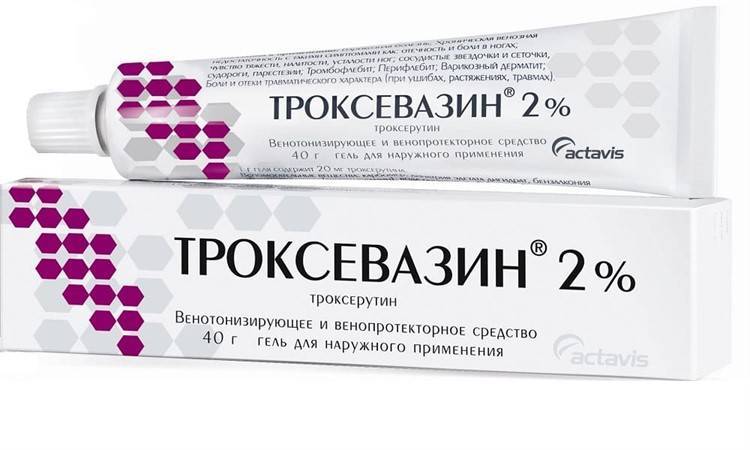
Troxevasin ointment
For the same reason, you should not warm the lump yourself, even if it seems too big and painful to you. In this situation, you should consult your pediatrician.
An iodine mesh will help to quickly resolve the infiltrate. It is worn on the seal, and when it completely disappears, it is drawn again. A gauze compress soaked in a magnesium solution will also help. It is better to apply it to swelling before going to bed.
Among the natural remedies that can be used to reduce infiltration, it should be noted:
- soda compress. Proportion: 1 tbsp. soda to 1/2 cup warm water. Tie gauze (or cotton cloth) soaked in soda to the seal and wait until it dries completely;
- fresh cabbage leaf. It should be lightly beaten with a hammer so that the juice comes out. Apply to the swollen area until it dries (about 2-3 hours);
- raw potato compress. Finely grind the tubers. Form a flat cake and wrap it in cheesecloth. This bandage relieves swelling well.
The compress must “breathe”, so do not use film or plastic bags.
If the vaccination was completed correctly, the compaction will go away quickly. Parents should know that a lump may appear not only during the first DTP injection, but also after the 2nd and 3rd vaccination. This is fine.
You should only worry if after vaccination the baby exhibits the following symptoms:
- the compaction does not subside for a long time or even increases (more than 6-8 cm in diameter);
- high (over 38.5 degrees) temperature;
- pus can be felt in the compaction, protruding at the puncture site;
- nausea and poor appetite;
- the infiltrate is “hot” and painful.
If the lump persists for up to two weeks after the injection, then doctors talk about the formation of a subcutaneous infiltrate. Such a formation is accompanied by redness, pain and in most clinical cases does not pose a danger to the baby’s health. A compaction up to 8 cm in diameter is considered normal. To alleviate the symptoms of infiltration, you can give the child an iodine network, which promotes its regression.
The injection site is red and swollen: normal or a complication?

Depending on individual factors, such a reaction may occur immediately after the injection or after some time. This process is not always pathological in nature. Therefore, there is no need to urgently contact a pediatrician. First, you need to determine what is within the normal range and what is a complication.
Redness, swelling and hardening of the skin at the injection site is a common reaction that occurs in approximately every fourth baby. As a result of repeated vaccinations, this side effect may intensify - this is due to the fact that children's immunity is finally formed.
The swelling at the injection site, which is up to eight centimeters in diameter, is normal and does not require any intervention. Exceeding eight centimeters in diameter indicates that the doctor’s requirements are not being followed, but such swelling is also safe.
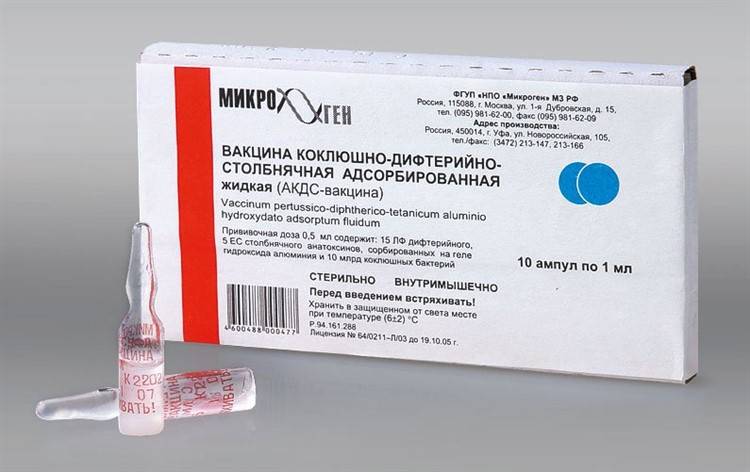
DPT vaccine
Complications include swelling and redness of the injection site, accompanied by additional side effects, including:
- an increase in body temperature above +38 ⁰C, persisting for two days;
- suppuration;
- severe skin itching, accompanied by crying and irritability of the baby;
- significant swelling spreading to surrounding tissues;
- the occurrence of a skin rash.
If any of the above manifestations occur, it is recommended to show the baby to a pediatrician as soon as possible.
Normal body reaction to DTP vaccination
Several drugs are used to immunize children: DPT, Pentaxim, Infanrix, Infanrix IPV, Infanrix Hexa, Tetrakok and Bubo-Kok. Pentaxim, in addition to whooping cough, diphtheria and tetanus, protects against Haemophilus influenzae and polio, Infanrix Hexa protects against polio and hepatitis B. The injection is given in a specific area of the body: for children the vaccine is injected into the outer part of the thigh, for older children and adults - into the shoulder.
READ ALSO: Pentaxim vaccination scheme
It is common for a young child to have a reaction to a vaccine. Side effects that occur after vaccination and do not pose a threat to the health of the baby:
- temperature rise,
- runny nose, cough,
- loss of appetite,
- weakness, lethargy,
- diarrhea, vomiting, colic,
- redness or swelling at the injection site.
If the temperature rises to 38.5-39°C or higher, convulsions, prolonged vomiting or diarrhea occur, you should immediately consult a pediatrician.
Loss of appetite, runny nose, weakness, drowsiness, slight swelling, redness are symptoms that often appear after DTP, but are not dangerous.
READ ALSO: what to do if the temperature rises after DTP?
The leg where the injection is given usually hurts for two to three days. Also, after the injection, an allergic reaction on the skin sometimes appears. Allergies occur after the second or third vaccination. If the injection site is red, to alleviate the condition, the child is given antihistamines, for example, Fenistil or Zyrtec (we recommend reading: how should you give Fenistil before DTP vaccination?).
READ ALSO: how to properly give Fenistil to a child?

Prevention helps to avoid adverse effects after DPT vaccination, such as bumps. Prepare your child for vaccination (start giving him antihistamines three days before it) and make sure that sanitary standards are observed during the procedure. The child's health is carefully monitored for several days after immunization. It is not recommended to wet or rub the injection site on the first day.
READ ALSO: Is it possible to bathe a child immediately after DTP vaccination?
Swelling of an area of the thigh or swelling of the entire leg
It happens that after the administration of DPT or Pentaxim, the area of the thigh where the drug was injected, or the child’s entire leg, swells. This is the body's immune response, meaning the vaccine has started to work. How long the swelling will not subside depends on the baby’s immunity, as well as on how correctly the procedure was carried out.
READ ALSO: what to do if after DTP vaccination the child cannot stand on his leg?
Infiltrate (bump, lump) at the injection site
Sometimes the lump that appears after DTP does not disappear within two weeks. If the compaction is not very large (no more than 8 cm), it does not pose a danger; this is a natural reaction of the body. To ease the pain in the leg and reduce the size of the compaction, doctors recommend using simple means, for example, making an iodine mesh at the site of infiltration formation.
Redness and itching
At the site where the DPT vaccine was given, slight redness (a red spot 2-4 centimeters in diameter) and itching appears, caused by mild local inflammation due to the procedure. This is also not a cause for concern; the redness around the injection will subside within a few days. If the redness is severe, anoint the skin with a special anti-inflammatory ointment.
READ ALSO: when is the 4th DPT vaccine given, and how is it tolerated?
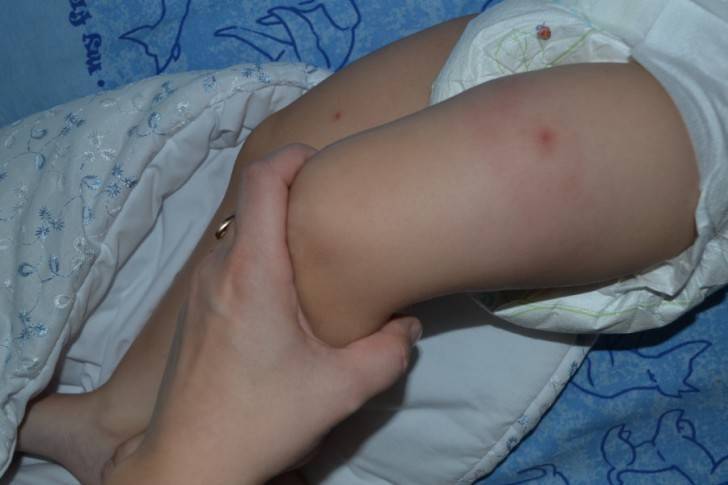
When to see a doctor
The following symptoms after vaccination in the child may be a cause for concern for the mother:
- severe redness and an increase in the size of the seal greater than 8 cm;
- pain from touching the lump;
- continuous crying of the baby;
- temperature above 39.0 °C;
- allergic reaction;
- convulsive syndrome.
If such symptoms appear after vaccination, you must call an ambulance or take the baby to the nearest hospital.
What body reaction is considered normal?
According to statistical studies by doctors, every sixth vaccinated child experiences complications after DTP. The most common reaction to the vaccine is a slight hardening at the injection site, which is currently regarded as normal and does not need correction.
Since babies are injected into the outer thigh, the lump develops here. The leg after DTP vaccination may hurt for about 3-4 days, and then go away on its own and without consequences. An allergic reaction at the injection site usually occurs after the second vaccination. It is easy to prevent it if you start giving your child antihistamines 3 days before the vaccination.
Other reactions to the DTP vaccine include:
- a rise in body temperature to 38 C (if the temperature rises to 38.5-40 C, then you must immediately show the child to a doctor);
- the occurrence of catarrhal manifestations in the form of a runny nose and cough;
- short-term loss of appetite;
- weakness and lethargy for 1-2 days after the injection;
- changes in the digestive tract, in particular, diarrhea, colic, single vomiting.
Several drugs are used to immunize children: DPT, Pentaxim, Infanrix, Infanrix IPV, Infanrix Hexa, Tetrakok and Bubo-Kok. Pentaxim, in addition to whooping cough, diphtheria and tetanus, protects against Haemophilus influenzae and polio, Infanrix Hexa protects against polio and hepatitis B. The injection is given in a specific area of the body: for children the vaccine is injected into the outer part of the thigh, for older children and adults - into the shoulder.
It is common for a young child to have a reaction to a vaccine. Side effects that occur after vaccination and do not pose a threat to the health of the baby:
- rise in temperature;
- runny nose, cough;
- loss of appetite;
- weakness, lethargy;
- diarrhea, vomiting, colic;
- redness or swelling at the injection site.

To reduce the unpleasant symptoms that occur after vaccination, you can use the following options to help your child:
- get a massage;
- apply a compress to the injection site;
- smear the leg in the place where it is swollen with a special ointment.
If after vaccination a child’s temperature rises above 38.5°C, the redness intensifies and the leg is very swollen, you can anoint the sore spot with Troxevasin gel or make a compress with novocaine. This will eliminate redness and ease pain. Also give your child the antipyretic medicine Nurofen or Paracetamol in syrup form. You can use a rectal suppository with paracetamol.
If the compaction that appears after DTP does not go away, in addition to the indicated drugs, the following remedies can be used:
- for allergic itching, swelling and redness, infants will benefit from Fenistil in drops, for babies over 1 year old - 5 drops of Zyrtec 1-2 times a day, and for children over 2 years old - Claritin syrup, a teaspoon once a day;
- Aescusan ointment and Troxerutin gel improve blood circulation and accelerate wound healing;
- Rescuer ointment reduces inflammation and resolves bumps;
- Heparin ointment enhances tissue microcirculation and relieves swelling.
To reduce the unpleasant effect of the vaccine, you can apply a cabbage leaf to the injection site.
Often parents, when a child develops an infiltrate at the injection site, resort to folk remedies:
- Cottage cheese compress. The product should be heated in a water bath, wrapped in soft cotton cloth and applied to the seal until the curd cools.
- Honey compress. Heat the honey, add the egg yolk and a little olive oil. Mix everything, form a cake, wrap it in cotton cloth and apply it to the pine cone, covering it with parchment on top.
- Cabbage leaf. Apply to the infiltrate before going to bed.
- Compress made of honey and flour. Mix heated honey and rye flour in equal proportions. Make a cake and apply it to the seal before going to bed.
- Soda compress. Dilute a teaspoon of soda in a glass of warm water, moisten a cotton handkerchief in the soda solution and tie it to the swelling until the bandage dries.
Do not use film or plastic bags when applying a compress. They create a greenhouse effect, which intensifies the inflammatory process.
DPT lump does not resolve
If pharmacological remedies do not bring results and the DPT lump does not resolve, then the mother can try effective remedies:
- A solution of sodium bicarbonate is applied to the cone. It is diluted in a ratio of 1:250 ml. Cotton compresses are applied twice a day;
- Applying steamed cabbage leaf. The sheet is treated with boiling water, cuts are made, and applied to the wound. You can keep cabbage for up to 5 hours. The leaf treated with boiling water is distinguished by its antiseptic properties and helps eliminate any signs of inflammation. It is also important to make small cuts so that the leaf lets out liquid and becomes soft;
- Use of honey and aloe. Early in the morning, the lump is treated with juice, and honey is applied as a compress before bed. The plant stands out for its characteristics of resorption of fluid accumulations in tissues. However, in order for all the active substances to start working, it is recommended to keep the stem for several hours in a cold place. It is best to use the side shelf of the refrigerator compartment for this. Next, a gel-like liquid is squeezed out of the plant; it is best to use a fine grater, juicer or other available household devices. Previously, the plant was simply crushed and the juice was filtered through a porous cloth. Such a compress will work to eliminate the bump for several hours;
- An effective way to remove the bump is to apply raw potatoes - a large fruit is peeled and cut into several parts. The main thing is to fix it correctly so that it is in contact with the site of the lump for several hours. What are the beneficial properties of potato starch? It quickly removes excess fluid from the body, thereby reducing inflammation. Starch will enter the wound, even if the potato is cut into large pieces. But, to achieve a better result, it is recommended to grate it. The pulp is placed in a porous bag and applied to the inflamed area;
- Clay with a white tint - applied to the affected area during daytime sleep, then the residue is cleaned off with a cotton pad.
Popular What are the benefits of hardening for children in the garden or at home?
Before applying any of these products to a wound, make sure that your baby does not have any negative reaction, including a rash or sneezing.


